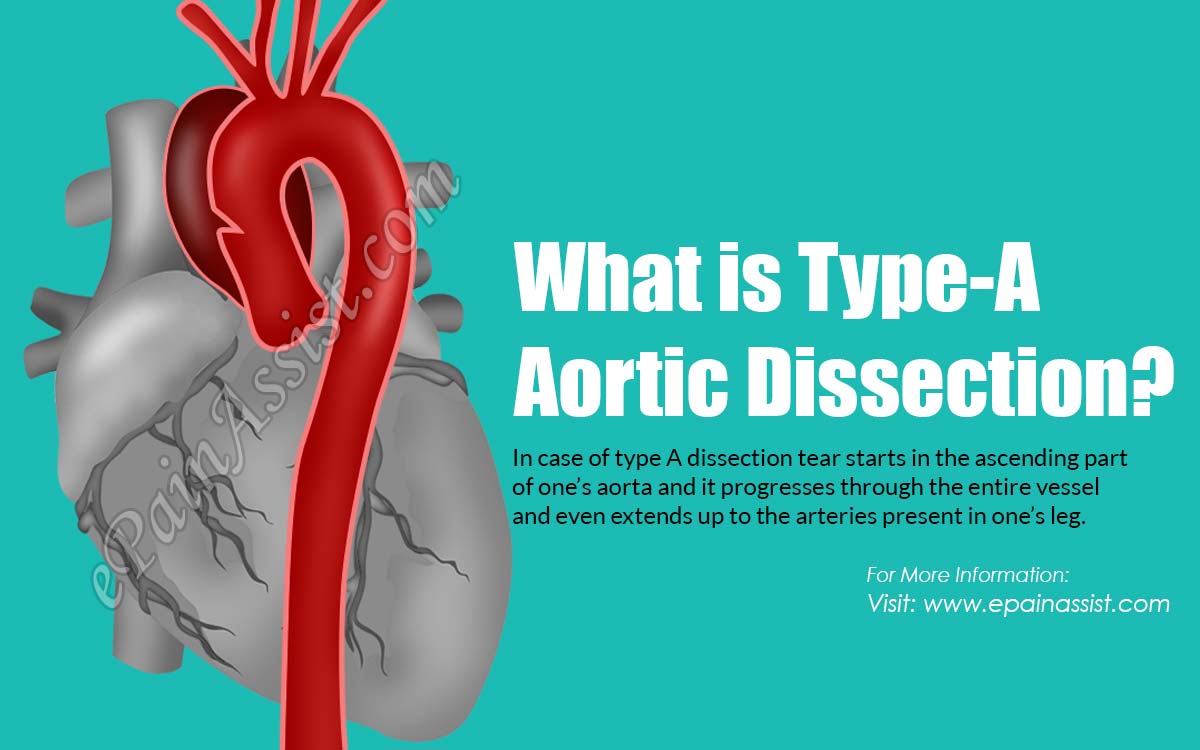Aortic dissection indicates a tear in the inner lining of one’s aorta. This tear helps in the flow of blood from aorta walls instead of staying in the lumen i.e. the central channel. Until now, patients have suffered from two major types/forms of aortic dissection referred as Type-A dissection and Type B dissection, defined mainly based on the tear’s exact location.

What is a Type-A Aortic Dissection?
Type A Dissection: In case of type A dissection tear starts in the ascending part of one’s aorta and it progresses through the entire vessel and even extends up to the arteries present in one’s leg.
Type B Dissection: Tear remains present only in descending aorta of a patient and may extend within the abdomen area.
Distinction present in between the mentioned two types is very much essential, as it forms a proper guide associated with management of the problem. Reason for this is that Type A requires immediate surgery to avoid death from heart attack, stroke, bleeding or congestive type of heart failure. On the other side, type B aortic dissection constitutes a medical condition treated initially with aggressive control in the blood pressure. Additional treatment remains reserved in general to deal with complications associated with the tear.
Why Type-A Aortic Dissection is Severe?
Acute form of Type-A Aortic Dissection consistently remains a severe or a catastrophic event and it requires emergency surgical intervention. Procedure in this case starts typically with an intimal tear formed within the middle of ascending aorta that allows splitting of the blood and thereby, creates a risk proximally towards the aortic root and distally within the remaining areas of ascending aorta within the arch. If this condition remains untreated-
Edema: Insufficiency of the proximal acute aortic valve happens and that results in acute pulmonary type of edema
Ischemia: Compromised perfusion of various coronary arteries, which may result in lethal arrhythmias, ischemia and myocardial infarctions
Stroke: Malperfusion of various arch vessels resulting in big strokes.
Pericardial Tamponade: Ascending aorta rupture and leakage resulting in pericardial tamponade and/or exanguination.
Diagnosis of Type A Aortic Dissection
Diagnosis or detection of Type A aortic dissection is obviously a tricky task, as the symptoms present in it are almost similar to any other type of health problem. Doctors usually suspect any aortic dissection based on the presence of the following signs and symptoms-
- Sudden ripping or tearing of the chest pain
- Aorta widening on the chest X-ray
- Difference of blood pressure in between left and right arms.
Although, the mentioned signs and symptoms suggest for the problem of aortic dissection, doctors require relatively more sensitive type of imaging technique to diagnose the problem accurately. These are:
Transesophageal Echocardiogram: Transesophageal echocardiogram test involves the usage of a high-pitch sound wave to produce the heart’s image.
Computerized Tomography Scan: Computerized Tomography Scan primarily generates X-rays for producing various cross-sectional images of a human body, including diagnose of aortic dissection.
Magnetic Resonance Angiogram: Magnetic Resonance Angiogram test utilizes a magnetic field and radio wave pulses to create pictures of the patient body.
Treatment of Type A Aortic Dissection
Aortic dissection requires an immediate treatment or a medical emergency. Therapy may include medications or surgery depending on the involved area.
Treatment for Type A aortic dissection will include-
Surgery for Type A Aortic Dissection
Surgeons in this case remove most of the dissected aorta as possible and block the entrance of blood within the aortic wall. In addition, aorta comes with a synthetic tube referred as graft. In case of any leakage in the aortic valve because of damaged aorta, you have to replace it simultaneously. Doctors place the new valve inside the graft used primarily for the aorta reconstruction.
Medications for Type A Aortic Dissection
Doctors recommend for a few medications, like nitroprusside and beta-blockers to reduce the heart rate and reduce the blood pressure. This helps in the prevention of aortic dissection from getting worse. Doctors recommend it to Type A aortic dissection for stabilizing the blood pressure before doing any surgical process.
- Mayo Clinic. (2021). Aortic Dissection. https://www.mayoclinic.org/diseases-conditions/aortic-dissection/symptoms-causes/syc-20350688
- Cleveland Clinic. (2021). Aortic Dissection. https://my.clevelandclinic.org/health/diseases/17549-aortic-dissection
- American Heart Association. (2021). Aortic Dissection. https://www.heart.org/en/health-topics/aortic-aneurysm/what-is-an-aortic-aneurysm/aortic-dissection
